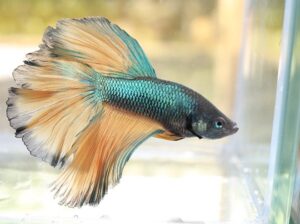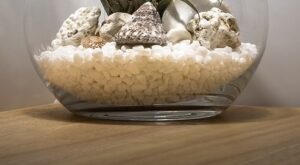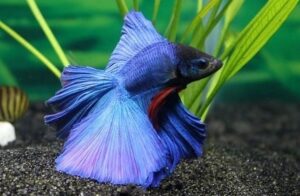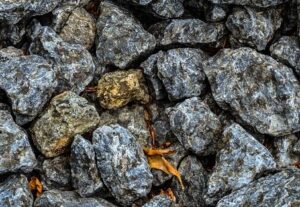If you think that finding the best substrate for your betta is an easy and simple task, then you are very much mistaken.
You might think that you can just rush to your nearest sandpit and get sand to fill the bottom or go to your nearest stream and pick out rocks for your aquarium.
But there is a lot more to it than you think when it comes to the best substrates for bettas.
A betta requires certain things in order to thrive in your tank. If they are overlooked then you might cut the lifespan of your betta by keeping it prone to health issues and infections.

In this buyer’s guide “Best Substrates For Bettas,” you will learn about:
- the general information of the betta fish
- the reasons why you should have substrates for them
- the best substrates available in the market
- the pros and cons of each product
- common questions when it comes to the best substrates for bettas
There are a lot of substrates available in the market but that doesn’t mean that they are all meant for your fish. This buyer’s guide will equip you with the knowledge you need if you want to keep your betta happy and healthy.
VivariumTips.com is a participant in the Amazon Services LLC Associates Program, an affiliate advertising program designed to provide a means for us to earn fees by linking to Amazon.com and affiliated sites.
Check Betta Substrates
Best Substrates For Bettas: Introduction of The Infamous Fish

The ‘Siamese fighting fish’ or widely known as betta fish is a very popular fish. It is a high demand fish in the aquarium trade industry as well.
The betta fish is a highly territorial fish; this means that it can’t be housed with another betta.
The male betta especially, will fight and sometimes even kill the other over territory. So it is advised only to keep a single betta in a tank.
It originated from Thailand where it was first used as a betting means.

When it comes to betting and betta fish…
People would place two betta fish in a single enclosure where people would place bets on either one of the fish. The first betta to back down or die would lose.
This was a very cruel practice but nowadays these fish are only used for their beauty and uniqueness. You should avoid this practice at all costs!
Why Should You Have Substrates For Bettas?
There are many reasons why substrates can be beneficial for bettas.

Let’s take a look right below.
Substrates Can Help Contain Bacteria

If you are familiar with the nitrogen cycle then you might know that bacteria are very essential.
If you didn’t know yet, then you should keep this in mind:
Some bacteria are known to break down nitrites, nitrates, nitrogen, and ammonia.
The presence of these can negatively impact the health of your betta.
This is why substrates are preferred as they contain the essential bacteria needed to keep the fish healthy in the tank.
Increases Aesthetic Appeal

One of the main reasons that substrates are used is because people generally want to increase the aesthetic appeal of their aquarium.
Substrates are found in various color options and looks.
Betta Substrate Advice:
It is advised not to leave your aquarium floor barren as this can cause your betta to freak out.
Another reason is that light reflections from the empty floor can be quite harmful to your betta.
Gives Bettas A Better Appearance

A substrate can really bring out the colors and look of your betta.
This is the case if you decide to go with natural and dull colors for your substrates.
It can allow your betta to be the star of the show as the colors will be more prominent in the dark environment.
Makes The Environment Appear More Natural
A barren aquarium floor isn’t advisable for multiple reasons, which is why substrates are used to provide a much better look.
Substrates create a more natural environment for your bettas.
Not only does it make it appear nice but also…
This can greatly benefit bettas as well because it makes the bettas more comfortable and makes it easier for them to adjust and thrive in the simulated environment.
Vegetation
Substrates cover the whole bed of your tank along with making the tank feel more full and natural. Substrate allows for vegetation to be placed on the floor as it is kept in place by the said substrate.
The natural environment for betta calls for vegetation.
The betta can hide and feel more at home if vegetation is present.
Certain vegetation can also help in keeping the water clean from impurities.
Helps With pH Level
Some substrates maintain the ideal pH level required by your betta.
A substrate can make the water soft or hard and can get rid of substances which could have a negative impact on the betta.
Some substrates make the water alkaline and some make it more acidic.
The proper substrate should be used in order to maintain that equilibrium according to the requirements of the fish.
Best Substrates For Bettas You Can Find Online

Sackorange Aquarium Gravel River Rock
Gravel is one of the most widely used substrates and it is readily available from any local shop, online seller, or aquatic center. It is quite popular and is available in a wide variety of colors and shades to spice up your aquarium. It is also relatively inexpensive so you can easily stack up on it if you need to.
The Sackorange aquarium gravel is a great and affordable pick.
[i2pc pros_icon=”icon icon-check-4″ cons_icon=”icon icon-cancle” show_title=”true” title=”Pros & Cons” show_button=”true” pros_title=”Pros” cons_title=”Cons” button_icon=”icon icon-cart-4″ link_text=”Check Price on Amazon” link=”https://amzn.to/3fhDSeZ” ][i2pros]Gravel isn’t quite as tightly bound. This allows for plant and vegetation growth which is already a great addition for bettas as their natural environment calls for vegetation.
As gravel is quite heavy and has a larger surface area, it decreases the chances of getting stirred up by your fish. It won’t make the tank muddy and messy as well which is a great bonus.
Aquarium gravel is quite easy to clean as the gravel is quite large in size and requires little maintenance. You can find polished gravel online or in your local store which allows for a great look and keeps the tank clean.
Your bettas will not eat up the gravel if you get one that is larger in size. This will decrease the betta’s chances of getting sick or hurt if they consume their substrate.
[/i2pros][i2cons]If you feed your betta with live feed and use gravel as a substrate then you might have a huge problem. This is because the live feed can hide between the crevices of the gravel and can even overbreed.
Gravel comes in random shapes and sizes, some are even sharp around the edges. This is a safety hazard for your betta. Your betta might get too close to the surface and scratch or puncture itself from the jagged gravel edges. This can result in infections and even death.
If you chose gravel that is quite large in size then you might be met with the problem of your aquarium vegetation floating away from the surface of the substrate[/i2cons][/i2pc]
Gravel is one of the best options for people looking to buy a substrate for their bettas. There are however some implications that need to be addressed.
The gravel should be moderately sized, smooth, and compact. If these requirements are met then this might be the best betta fish gravel for your tank.
Caribsea Super Naturals Aquarium Sand
The Caribsea aquarium sand is another option for people looking for the perfect substrate for their bettas. This is quite popular and is quite affordable as well. This is generally used for bottom-dwelling fish but can be used for bettas as well.
[i2pc pros_icon=”icon icon-check-4″ cons_icon=”icon icon-cancle” show_title=”true” title=”Pros & Cons” show_button=”true” pros_title=”Pros” cons_title=”Cons” link_text=”Check Price on Amazon” link=”https://amzn.to/39D4Qga” ][i2pros]A similar substrate to the natural substrate found in the living environment of bettas. This can make it easier for the betta to adjust and feel comfortable in the aquarium
There aren’t any sharp or jagged edges in the sand which could injure or bruise your betta which would then lead to infection and maybe even death
A great advantage of using aquarium sand is that it is quite compact. This level of compactness is great if you feed your betta live feed. Live feed can’t hide in the sand and doesn’t leave any chance of over breeding
Aquarium sand is readily available in any local shops, online stores, and aquatic centers. It is also relatively inexpensive and easy to use and spread across the bottom of your tank.
[/i2pros][i2cons]The fine grain and light nature of aquarium sand can cause it to float around when you first put it in. This can make the tank look quite dirty and murky. If you have bottom dwellers in your tank that might mix around the sand then the tank would always be murky and difficult to maintain
The production of Hydrogen Sulfide can be caused by bacteria buildup in the sand surfaces. This can negatively impact the water and your betta’s health. It can be treated by moving and swirling the sand every so often
It is difficult to put in vegetation in the substrate as it is so compact. You might have to put in rocks and coral in order to secure the vegetation for your betta
[/i2cons][/i2pc]
This is a great and viable option for people who are looking for a great substrate for their betta fish. It requires a bit of maintenance but it is great if you don’t have any bottom dweller fish as that will make the water murky.
Dashington Flat Cobalt Glass Marbles
Marbles are a widely used substrate by new fish owners. These marbles are present in different colors and shades. They are also available in different sizes as well according to the size of your aquarium and the type of fish you have.
The Dashington marbles are aesthetically pleasing and provide a great look to your tank as well.
[i2pc pros_icon=”icon icon-check-4″ cons_icon=”icon icon-cancle” show_title=”true” title=”Pros & Cons” show_button=”true” pros_title=”Pros” cons_title=”Cons” link_text=”Check Price on Amazon” link=”https://amzn.to/2BIitOB” ][i2pros]If your betta has babies then the gaps between the marble can be a safe place for them to reside
A very good option for smaller tanks as they are much easier to clean and maintain
Aesthetically pleasing
Affordable and easily available in local shops, aquatic centers and online
[/i2pros][i2cons]The large gaps between the marbles can cause the live feed to hide from your betta
Does not provide the exact natural environment your betta needs to thrive
[/i2cons][/i2pc]
This is a great option for beginners and provides a great aesthetic appeal to the tank.
Fantasia Bulk Madagascar Stone Mix
These are great quality stones that come in various colors and shades. They are very affordable as well but must be handled and treated with care to make it safe for bettas.
These are a great find if natural rocks aren’t available near you.
[i2pc pros_icon=”icon icon-check-4″ cons_icon=”icon icon-cancle” show_title=”true” title=”Pros & Cons” show_button=”true” pros_title=”Pros” cons_title=”Cons” button_icon=”icon icon-cart-4″ link_text=”Check Price on Amazon” link=”https://amzn.to/2BG8R6O” ][i2pros]Available in a wide variety of shapes, sizes, and colors which can complement the aesthetics of your aquarium and making a more livable environment for your fish
Can provide hiding spots for you bettas for them to feel more comfortable and not prone e to being stressed out
Natural stones can be easily collected from any natural environment, for example, your local stream or even from the side of a road
They are technically free if you pick them out yourself and can end up saving you quite a lot of money
[/i2pros][i2cons]These natural stones have crevices and are not compact which can lead to living feed hiding in it making it difficult for your betta to sustain a healthy lifestyle
If the substrate is not properly cleaned then it might adversely affect the health of your fish by changing the pH level, poisoning the water or making the water murky
[/i2cons][/i2pc]
These rocks are not generally recommended because you might end up killing your precious fish. If you are experienced and know how to properly treat this type of substrate in order to make it safe for your fish then this is a viable option.
Nature’s Ocean Bio-Active Live Aragonite Reef Sand
Coral sand is more like gravel instead of regular sand in nature. As it has a larger form factor, it allows for vegetation and maintains the proper pH of the tank if it is maintained.
Nature’s Ocean coral sand is a popular choice and is readily available online and in aquatic centers closest to you.
[i2pc pros_icon=”icon icon-check-4″ cons_icon=”icon icon-cancle” show_title=”true” title=”Pros & Cons” show_button=”true” pros_title=”Pros” cons_title=”Cons” button_icon=”icon icon-cart-4″ link_text=”Check Price on Amazon” link=”https://amzn.to/2DmOlsE” ][i2pros]Removes nitrogenous waste from the water making it more livable for your betta
Maintains the proper pH if it is regularly monitored
It is quite an affordable option
Coral sand is closer to gravel in nature which means it allows vegetation to anchor in the base of the tank
[/i2pros][i2cons]If not monitored and changed after a certain period of time, coral sand tends to dissolve in the water. As it is made up of calcium carbonate it can adversely affect the water pH levels for your bettas and can make it more alkaline
It is not as easy to maintained and clean as it requires regular cycles
[/i2cons][/i2pc]
Overall coral sand is a viable option only for those who are willing to clean up their tanks quite regularly and know how to properly measure and control the pH levels of the aquarium.
Substrates For Bettas Frequently Asked Questions
Below are the frequent questions people are asking about substrates and bettas.
What Is A Substrate?
A substrate refers to the materials used in an aquarium. They are laid in the bottom of the tank and have an adverse effect on the water and inhabitants inside. They can alter the filtration of the water; water chemistry and they can affect the health and livelihood of the inhabitants of the aquarium. A substrate is also used to increase the aquarium’s aesthetics.
Can You Keep More Than One Betta In An Aquarium?
In short, the answer is no. You might be used to keeping all your goldfish in a single tank and never having to worry about anything. Well, this is not the case when you purchase a betta. A betta is known to be very territorial and hence they will kill and fight any other betta in the tank. So it is advised not to put more than one betta in a single aquarium.
Can A Betta Be Kept With Other Types Of Fish?
As you know, not more than one betta can be kept in a single tank. You might be wondering that maybe you can’t keep other fish with a betta as well. Even though bettas are highly territorial, they can be housed with certain fish. These include Ghost shrimp, Guppies, Cory Catfish, etc. just be sure to check if the fish you are trying to place in the betta’s tank is even compatible.
Do I Have To Buy A Huge Quantity Of Substrate For My Betta?
This all depends on the substrate you are going for as that will affect the packaging. If you are choosing natural rocks then you can collect the required amount from wherever you please. But if you are going with aquarium gravel then you have to purchase bags in large quantities. If your tank is big enough then these might be a one time use for you.
What Is The Natural Substrate Of Bettas?
Bettas are usually found in slow-moving streams, marshes, rice paddies, and drainage ditches. This means that the normal substrate would be silt, mud, soil, and vegetation. Now, this would be all fine and dandy I the wild but this cannot be sustained in your home aquarium. This would lead to sanitation issues and would be a hassle for you to maintain.
Can I Use Regular Sand As A Substrate?
People think that they can go to their nearest sandpit and scoop some out for their fish. This is not advisable as regular sand can have some adverse effects on the environment of the aquarium and can be harmful to the inhabitants as well. Sand can lead to bacterial growth and blooming of brown algae.
Factors To Look For When You’re Buy Substrates For Betta Fish
Here are the five factors you should look out for when you’re in the process of buying substrates for your betta fish.
- Safe
- Clean
- Looks
- Price
- Quantity
Check If The Substrate Is Safe
When looking for the perfect substrate for your bettas, you need to research thoroughly to see if the option you are going for is even safe for your fish.
Certain substrates create unlivable environments for your betta.
Just be sure to choose a substrate that is compatible with the living environment your betta needs to survive.
Bettas thrive in clean water and some substrates might make that impossible by making the water murky and dirty.
This is another reason why bettas can’t be kept with all types of fish as the water requirements are not the same.
Avoid Dirty Substrates
A substrate should be chosen that keeps the tank and aquarium clean and free from any muddy or murky water.
A betta requires a clean environment and some substrates are known to be quite dirty if they are stirred up.
Just be sure to correctly choose the substrate so that your fish can thrive.
Find Your Desired Product After You Have A List Of Compatible Substrates
If you are convinced that the substrate you have chosen is completely compatible with your betta then you can think about it further.
Usually, in any substrate you chose you are presented with a wide array of colors and shades.
These complement your aquarium atmosphere and can greatly add to the aesthetic appeal of your tank.
Finding The Price That Best Fits You Budget
When choosing a substrate, you can be greatly overwhelmed by the wide selection of a single substrate. These can greatly vary in pricing and features.
The health of your betta should be your utmost priority instead of looking for the cheapest option. Once you have a compatible list of substrates, then figure out the price after.
But this does not mean that you end up overpaying for some fancy packaging or color.
Just remember to pay for the actual product and not the marketing.
The Right Quantity
If you have a small tank and are worried about the quantity of substrate you would have to buy then don’t be. A substrate might come pre-packed with mentioned weights. When choosing the substrate you require, look for the appropriate amount you will need to fill the bottom of the tank.
But if you cannot find smaller quantities, you could always buy the larger quantity and save the rest for another time.
Going this route can actually save you a bit of money in the long run as you would already have the amount you required and won’t need to buy more.

All the options presented each have their own effects and are to be considered when choosing a substrate for your betta. But overall I think that the best option is the aquarium gravel.
This is because it provides a much more natural environment and doesn’t affect the water and its pH level. It cleans up the water instead and makes it more livable for the betta.
In the end, it is however up to you and your requirements and which substrate is the most suitable for you and your betta.
From VivariumTips,
Even if you are satisfied with the knowledge you have gained from our article, just be sure to thoroughly research yourself as to which option is the best for you and then go from there.
Hopefully, this presented information has helped you in narrowing your options and might lead you to make an informed decision.
Be sure to check out my other buyer’s guide:
- Best Basking Bulbs For Reptiles + Quick Review
- Best Cherry Shrimp For Sale – Online – Fast Shipping
- Exploring Isopods And Springtails For Sale
- Discovering The Marimo Moss Ball Terrarium Kit!
- Best Air Plant Terrarium Kits For Your Home!
- Best Terrarium Books For Beginners, Adults, And Kids
- Reasons To Buy Zoo Med Excavator Clay
If this article helped you find the best substrates for bettas, then be sure to leave a review of the product below. For any questions, don’t afraid to post below this article and I’ll answer it as soon as possible.
You can support VivariumTips by sharing this buyer’s guide with a friend/community! 🙂






